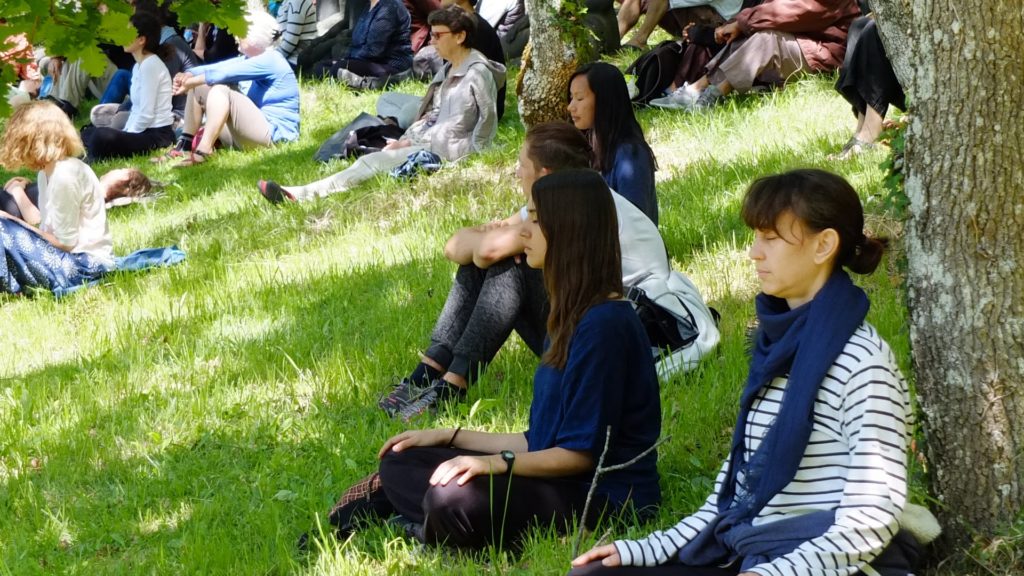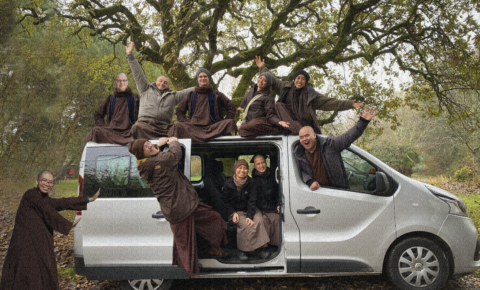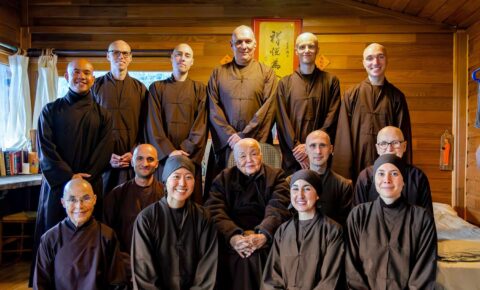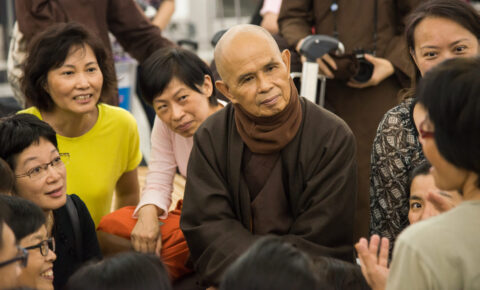Sitting meditation is one of the basic Plum Village mindfulness practices. Brother Phap Luu offers guidance on how we can get started.
It’s wonderful to practice sitting meditation: to stop whatever we’re doing, let go of our projects, our worries, and just sit there, being with our breathing, being with our body and looking to see what’s coming up inside.
Sit comfortably
To practice sitting meditation, we can find a comfortable position for our body. You might like to have a cushion to put under your backside.
One option is to sit with your legs crossed, folded underneath one another. This creates three points of stability: the back side and then the two knees.
You may also like—if you’re more flexible—to sit in what we call the half lotus, which is with your foot up on your thigh.
If you feel even more flexible, some people like to sit in the full lotus, which is with both feet on the thighs. That may be uncomfortable for most of us to do.
If it’s difficult for you to sit in the cross legged position, you can also sit in a chair,or you might like to sit with the cushion between your legs so that you’re kneeling and the cushion supports you.
To find a stable position we can imagine that there’s a thread going up through our spine and coming out through the crown of our head. Imagine somebody pulling up gently on that thread. We relax our shoulders, letting them just hang, our chest is open and our back is upright.
In this way we’re stable; even if we feel a bit sleepy, we’re not going to fall over. You can put your hands either together on your lap or on your knees.
The main thing is to feel comfortable. Sitting meditation is not something that needs to be too formal; we don’t need to feel rigid or tight in our body. That rigidity is actually a kind of tension that’s also present in our mind. The most important thing is to relax.
You might like to close our eyes or just leave them half open with a gentle gaze on a point in front of us.
What do we do?
When we practice sitting meditation, we try to let go of any need to accomplish anything. We know that just being aware of our breath we can calm our mind and calm our body.
We can say to ourselves:
Breathing in, I become aware of my breath.
Breathing out, I’m aware of my out-breath.
Or simply:
In. Out.
All of our attention is on the breath.
It may happen that there’s thinking coming up about the future and our projects. Maybe there’s some worry about what’s going on in the present moment in the world. We might feel some fear.
Any time we notice thinking coming up, we just bring our attention fully back to the breath—to the visceral sensation of the breath coming in through the nose, filling our lungs, our belly perhaps rising. Breathing out, the air is expelled by our lungs, the belly falling, the air coming out through our mouth or our nose.
This is to cultivate mindfulness—mindfulness of breathing. The breath is a wonder. It’s always changing. Every time I bring awareness to my breathing, I notice that it’s not quite the same, there’s always something new. The breath is bringing oxygen into my body, calming my muscles, calming my whole body, nourishing the cells in my body.
By breathing in with awareness, I realize that I get in touch with my breath directly. It’s not just an idea.
Breathing in. I know, I’m breathing in.
Breathing out. I know I’m breathing out.
Don’t forget to smile!
You can smile! It’s a joy to be aware of our breathing. It’s a joy to be alive. If you’re breathing, it means you’re alive and being alive is a wonder—one of the greatest wonders.
Following the breath all the way through
As we continue with our sitting meditation, we can follow our in and out breath. As you breathe in, you notice the air coming in through our nostrils, going down through our throat; we follow the sensation of the breath coming down into our lungs. Then we do the same with the outbreath breath going out.
If thinking appears as I breathe in, I can be aware of it and bring my attention back to the breath. Then, breathing out, it may be that some worry about the past comes up. Again, we can bring our attention back to the breath.
This is already enough. We can sit for ten minutes, just being aware of the breath. We don’t need to attain anything. We do not need to try to achieve enlightenment, although you may feel lighter and more relaxed. Anytime you notice thinking, anxiety, worry, coming up, just bring the attention back to the breath.
Becoming aware of the body
As we master being mindful of our breathing, we can also be aware of our entire body. We can come back to the body and take refuge in our body. Usually we’re not aware of our body. We are thinking about something that happened, or that is happening, that makes us worry, and we forget entirely that we have a body. Meditation is a chance to come back and get in touch with this very body, to really feel it.
Breathing in, I’m aware of my whole body.
Breathing out, I smile to my body.
In, aware of the body.
Out, smiling.
You may notice that your shoulders naturally relax, that your body is free of tension. So we can continue on to the next exercise:
Breathing in, I relax my body.
Breathing out, I release any tension in my body.
In, relaxing the body.
Out, releasing tension.
By practicing like this, we realize the possibility of stopping our thinking. Thinking needs attention and so if our attention is entirely on our breath or entirely on our body, then it doesn’t have a requisite condition to manifest. It’s not suppressing thinking, but rather shifting our attention to the visceral experience of the breath and the body to bring about healing and calm.
I hope you enjoy sitting meditation.

You can enjoy more guided meditations on the Plum Village app or you might enjoy Thich Nhat Hanh’s book How to Sit.







Join the conversation